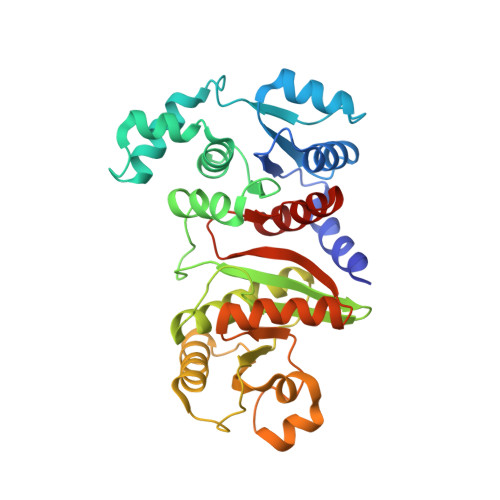Crystal structures of a phosphotransacetylase from Bacillus subtilis and its complex with acetyl phosphate
Xu, Q.S., Jancarik, J., Lou, Y., Kuznetsova, K., Yakunin, A.F., Yokota, H., Adams, P., Kim, R., Kim, S.-H.(2005) J Struct Funct Genomics 6: 269-279
- PubMed: 16283428
- DOI: https://doi.org/10.1007/s10969-005-9001-9
- Primary Citation of Related Structures:
1TD9, 1XCO - PubMed Abstract:
Phosphotransacetylase (Pta) [EC 2.3.1.8] plays a major role in acetate metabolism by catalyzing the reversible transfer of the acetyl group between coenzyme A (CoA) and orthophosphate: CH(3)COSCoA+HPO(4)(2-)<-->CH(3)COOPO(3)(2-) +CoASH. In this study, we report the crystal structures of Pta from Bacillus subtilis at 2.75 A resolution and its complex with acetyl phosphate, one of its substrates, at 2.85 A resolution. In addition, the Pta activity of the enzyme has been assayed. The enzyme folds into an alpha/beta architecture with two domains separated by a prominent cleft, very similar to two other known Pta structures. The enzyme-acetyl phosphate complex structure reveals a few potential substrate binding sites. Two of them are located in the middle of the interdomain cleft: each one is surrounded by a region of strictly and highly conserved residues. High structural similarities are found with 4-hydroxythreonine-4-phosphate dehydrogenase (PdxA), and isocitrate and isopropylmalate dehydrogenases, all of which utilize NADP+ as their cofactor, which binds in the interdomain cleft. Their substrate binding sites are close to the acetyl phosphate binding sites of Pta in the cleft as well. These results suggest that the CoA is likely to bind to the interdomain cleft of Pta in a similar way as NADP+ binds to the other three enzymes.
Organizational Affiliation:
Berkeley Structural Genomics Center, Physical Biosciences Division, Lawrence Berkeley National Laboratory, Berkeley, CA 94720, USA.
















